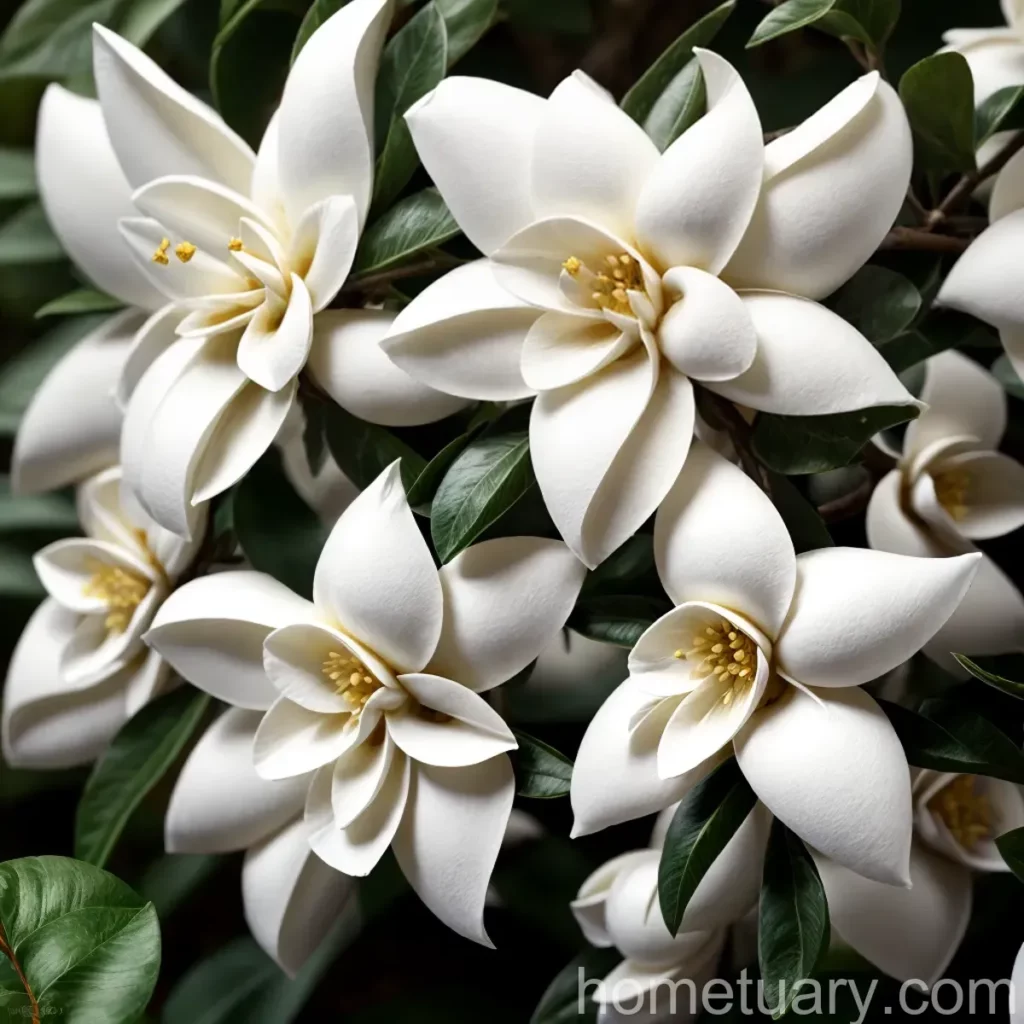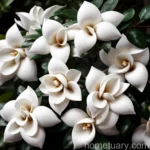Gardenia (Gardenia jasminoides ‘Shooting Star’): A Complete Guide to Care, Cultivation, and Maintenance
Introduction
Gardenias are renowned for their opulent and captivating fragrance, glossy green leaves, and beautifully intricate flowering. Amongst the various cultivars, Gardenia jasminoides ‘Shooting Star’ stands out due to its remarkable attributes. In this comprehensive guide, we will delve into the fascinating world of ‘Shooting Star’ Gardenia, providing insights into its cultivation, care, common issues, and more.
What is Gardenia (Gardenia jasminoides ‘Shooting Star’)?
Gardenia jasminoides, commonly known as Gardenia, is a species of flowering plant belonging to the family Rubiaceae. It is indigenous to Asia and is famed for its exquisite, fragrant white flowers and glossy, deep green foliage. Amongst the various cultivars, ‘Shooting Star’ stands out for its exceptional beauty and striking floral displays.
Key Takeaways – Gardenia (Gardenia jasminoides ‘Shooting Star’)
Before delving into the specifics of care and maintenance, let’s take a moment to understand a few key takeaways about the ‘Shooting Star’ Gardenia:
- Scientific Name: Gardenia jasminoides ‘Shooting Star’
- Plant Type: Evergreen shrub
- Flower Color: White
- Fragrance: Intensely fragrant
- Growth Habit: Bushy
- Best Suitable For: Gardens, containers, and landscape installations
- Hardiness Zone: 8 – 11
- Maintenance Level: Moderate to high
Culture
Uses
The ‘Shooting Star’ Gardenia is employed in various ways, owing to its mesmerizing flowers and fragrance. Common uses include:
- Ornamental Purposes: The exquisite blooms and lush green foliage make it a popular choice for ornamental landscaping in gardens, parks, and outdoor spaces.
- Aromatic Additions: The intensely fragrant flowers are often used in cut flower arrangements, adding a touch of elegance and a delightful aroma to indoor spaces.
Water
Proper watering is essential for the health and vitality of ‘Shooting Star’ Gardenia. Here are some essential tips for watering this plant:
- Regular Watering: Maintain consistent moisture for the roots by watering the plant regularly.
- Avoid Waterlogging: Ensure that the soil is well-draining to prevent waterlogging, which can lead to root rot.
Sunlight
Adequate sunlight is crucial for the growth and blooming of Gardenias. When cultivating a ‘Shooting Star’ Gardenia, consider the following sunlight requirements:
- Filtered Sunlight: Provide dappled or filtered sunlight to prevent scorching of the leaves.
- Partial Shade: Thrives in partial shade, especially during the hottest part of the day.
Fertilizer
Proper fertilization can significantly enhance the growth and blooming of ‘Shooting Star’ Gardenia. Follow these guidelines for fertilizing gardenias:
- Acidic Fertilizer: Apply a balanced acidic fertilizer designed for acid-loving plants, especially formulated for Gardenias.
- Frequency: Fertilize during the growing season, generally spring to fall, to promote healthy growth and floral abundance.
Soil
The soil composition plays a vital role in ensuring the well-being of ‘Shooting Star’ Gardenia. Here are some essential soil considerations:
- Acidic Soil: Gardenias thrive in acidic soil with a pH level between 5.0 and 6.0.
- Organic Matter: Incorporate organic matter such as peat moss or compost to improve soil texture and fertility.
Pruning
Pruning is a crucial aspect of maintaining the health, shape, and blooming potential of ‘Shooting Star’ Gardenia. Consider the following pruning tips:
- Deadheading: Regularly remove spent flowers to stimulate the production of new blooms and maintain a tidy appearance.
- Branch Pruning: Prune back any dead or overgrown branches to encourage new growth and maintain the desired shape.
Propagation
‘Gardenia jasminoides ‘Shooting Star’ can be propagated through various methods. Here are some common propagation techniques:
- Softwood Cuttings: Propagate Gardenias using softwood cuttings taken in spring or early summer for the best results.
- Air Layering: Another effective method involves air layering, which allows for the establishment of roots while the stem is still attached to the mother plant.
Container Popularity
The ‘Shooting Star’ Gardenia is particularly well-suited for container cultivation. Here are some reasons for its popularity in containers:
- Aesthetic Appeal: The captivating flowers and glossy green foliage make it an attractive addition to outdoor and indoor container gardens.
- Controlled Environment: Container cultivation allows for better control over soil composition, moisture levels, and sunlight exposure.
Common Diseases
Like many plants, ‘Shooting Star’ Gardenia is susceptible to certain diseases. Here are a few common diseases and their treatments:
| Disease | Symptoms | Treatment |
|---|---|---|
| Root Rot | Wilting, yellowing leaves, stunted growth | Improve soil drainage, remove affected plant parts |
| Leaf Spot | Spots on leaves, yellowing | Remove infected leaves, improve air circulation |
| Sooty Mold | Black mold on leaves, honeydew | Address pest issues, improve airflow |
Disease Diagnosis
Effective evaluation of symptoms is crucial for diagnosing and treating diseases in ‘Shooting Star’ Gardenia. Here are some diagnostic tips:
- Visual Examination: Carefully inspect the plant for any signs of discoloration, spots, or abnormal growth.
- Symptom Comparison: Compare the observed symptoms with common Gardenia diseases to identify the issue accurately.
Common Pests
Pests can pose a threat to the health and appearance of ‘Shooting Star’ Gardenia. Here are some common pests and effective control measures:
| Pest | Symptoms | Control Measures |
|---|---|---|
| Whiteflies | Tiny white insects on leaves, honeydew | Insecticidal soap, neem oil, natural predators |
| Aphids | Clusters of small insects on tender shoots | Water spray, neem oil, natural predators |
| Spider Mites | Webbing on leaves, stippling | Miticidal soap, neem oil, high humidity |
Botanist’s Tips
To ensure the optimal growth and well-being of ‘Shooting Star’ Gardenia, consider these expert tips:
- Consistent Moisture: Maintain consistent moisture levels for the roots, avoiding prolonged periods of drought or waterlogging.
- Optimal pH: Monitor and adjust soil pH to ensure it remains between 5.0 and 6.0 for ideal growth conditions.
- Seasonal Care: Adjust care practices according to seasonal changes, providing adequate protection during cold spells and adjusting watering in hot, dry conditions.
Fun Facts
To add a touch of intrigue to your Gardenia knowledge, here are some captivating fun facts:
- Symbolism: Gardenias are often associated with love, purity, and refinement, making them a popular choice for weddings and special occasions.
- Native Origins: The Gardenia jasminoides species is native to China and Japan, where it has been cherished for centuries for its beauty and fragrance.
Links to External Resources
For further information and resources on ‘Shooting Star’ Gardenia, explore the following links:
- The American Horticultural Society
- The Gardenia Forums
- Missouri Botanical Garden
- Royal Horticultural Society
In conclusion, ‘Shooting Star’ Gardenia is a captivating and aromatic addition to any garden or landscape, offering not only exquisite beauty but also a delightful fragrance. With the right care, attention, and understanding of its specific requirements, the ‘Shooting Star’ Gardenia can thrive and enchant for years to come.
By implementing the insights shared in this comprehensive guide, you can embark on a journey to cultivate and nurture ‘Shooting Star’ Gardenia, fostering its growth, health, and breathtaking floral displays.
Remember, with patience, dedication, and a touch of botanical expertise, the ‘Shooting Star’ Gardenia can grace your garden with its celestial beauty, captivating fragrance, and timeless allure.
Happy gardening!
Keywords: Gardenia care tips, Shooting Star Gardenia, Gardenia jasminoides ‘Shooting Star’, Gardenia shooting star variety, How to grow gardenias, Gardenia jasminoides care, Best conditions for gardenia plants, Gardenia plant maintenance, Gardenia shooting star flowers, Tips for growing gardenias, Gardenia jasminoides planting guide, Shooting Star Gardenia varieties, Gardenia jasminoides care instructions, Gardenia jasminoides ‘Shooting Star’ garden plant, Common issues with gardenias, Gardenia shooting star cultivar, Gardenia jasminoides ‘Shooting Star’ blooming season, How to propagate gardenias, Gardenia shooting star plant care, Gardenia jasminoides ‘Shooting Star’ pruning tips, Gardenia shooting star flowering tips, Tips for successful gardenia jasminoides cultivation, Best soil for gardenias, Gardenia jasminoides ‘Shooting Star’ water requirements, Gardenia plant diseases and treatments, Creating a gardenia jasminoides ‘Shooting Star’ garden bed, Gardenia shooting star shrub, Gardenia plant growth habits, Gardenia jasminoides ‘Shooting Star’ fragrance, Tips for attracting pollinators to gardenias, Gardenia shooting star soil pH requirements, Best fertilizer for gardenia jasminoides, Pruning techniques for gardenias, Gardenia jasminoides ‘Shooting Star’ sunlight needs, Companion plants for gardenias, Gardenia shooting star container gardening tips, Gardenia jasminoides ‘Shooting Star’ landscape design ideas, Pests that affect gardenia plants, How to prevent yellowing leaves on gardenias, Gardenia jasminoides ‘Shooting Star’ winter care, Improving gardenia plant health, Gardenia shooting star plant propagation methods, Gardenia jasminoides ‘Shooting Star’ pruning schedule, Common mistakes in gardenia care, Gardenia jasminoides ‘Shooting Star’ planting season, Gardenia shooting star plant size and growth rate, Natural pest control for gardenias, Gardenia jasminoides ‘Shooting Star’ indoor care tips, Companion herbs for gardenias, Repotting gardenia jasminoides ‘Shooting Star’ plants
References
- “Gardenia jasminoides”
https://www.fs.fed.us/database/feis/plants/shrub/garjas/all.html - “Gardenia Forums”
https://www.gardenia.net/ - “Missouri Botanical Garden”
http://www.missouribotanicalgarden.org/ - “Royal Horticultural Society”
https://www.rhs.org.uk/















